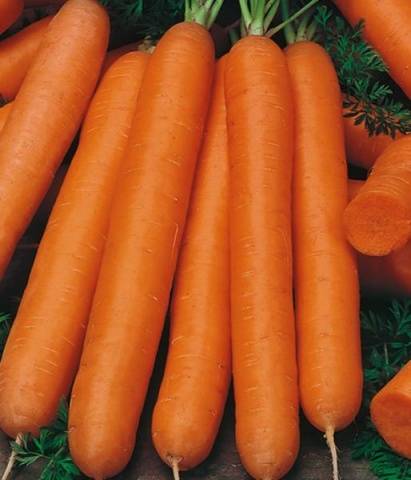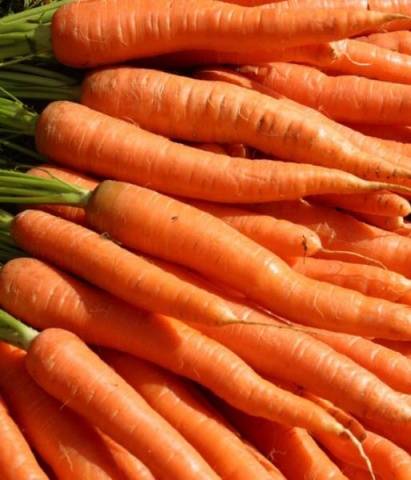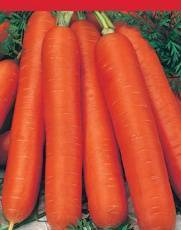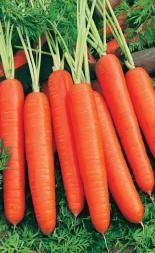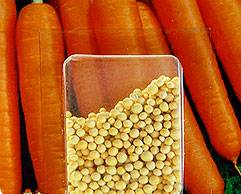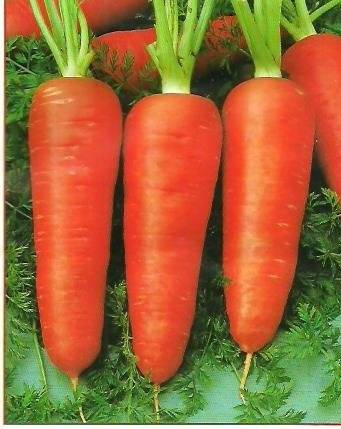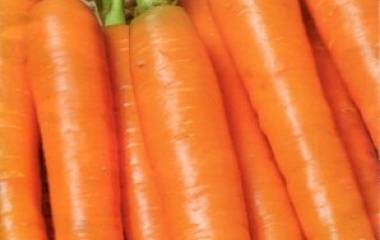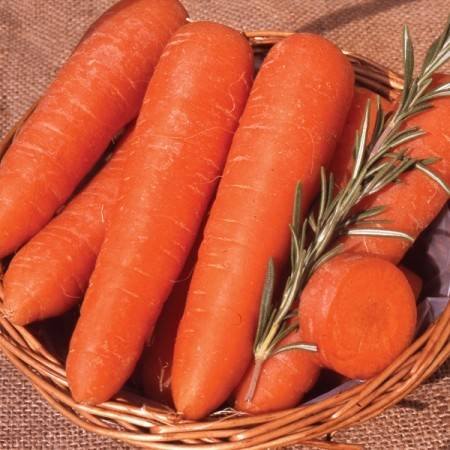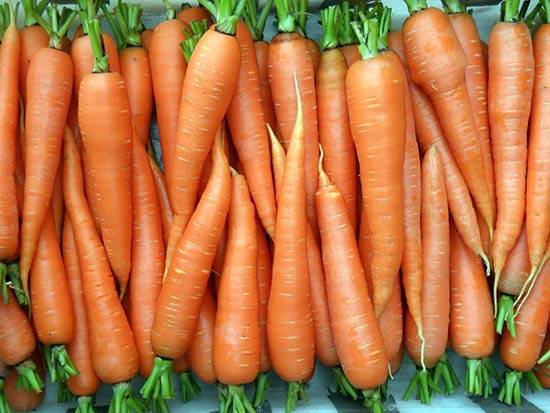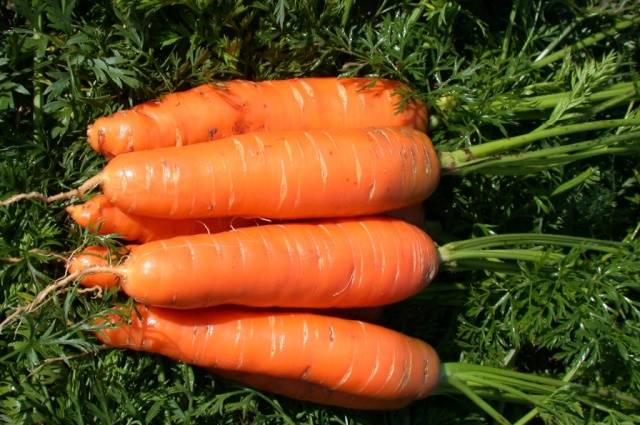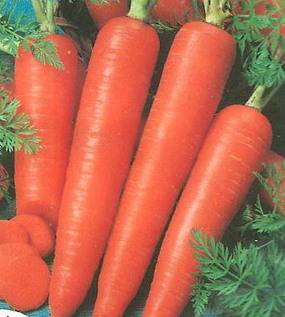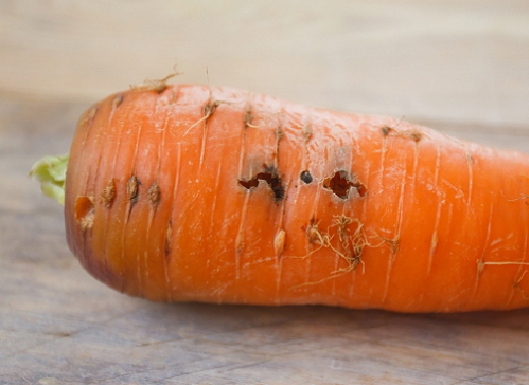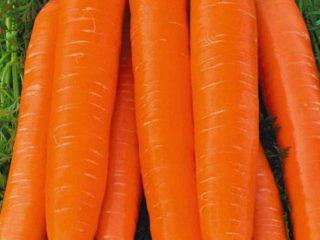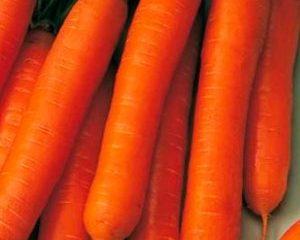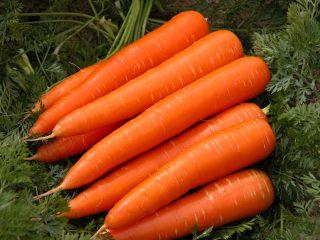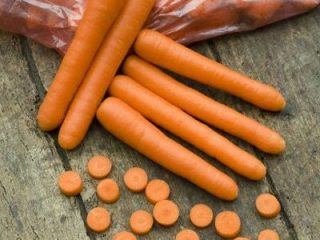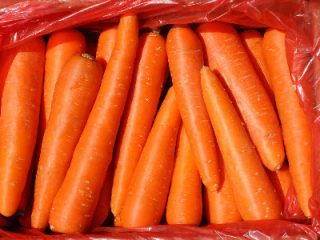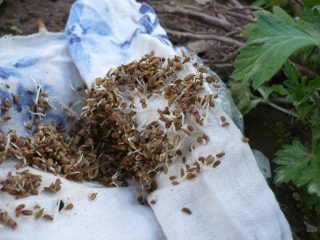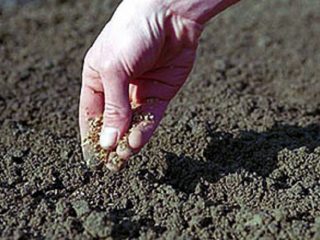Content
Carrots are considered one of the main sources of carotene, which is broken down into vitamin A in the human liver. Vitamin A is one of the components of many important processes in the human body:
- is a component of rhodopsin, which is responsible for night vision;
- accelerates the healing of superficial skin damage;
- helps maintain skin elasticity;
- helps improve immunity.
All these benefits occur at the cellular level. There is no point in smearing carrot juice on scratches in the hope of faster healing.
Parents usually know about the benefits of vitamin A and carrots as a source of carotene, and try to feed their child carrots, looking for sweet varieties, since not all children are enthusiastic about their parents’ ideas.
Not just sweet, but also very juicy, crunchy carrots were bred especially for children. After all, simply chewing something sweet is not as interesting as eating something sweet and crunchy.
Varieties of “baby” juicy carrots
Children's Sweetness
Mid-season variety of carrots with elongated cylindrical roots. The root vegetable has a rich orange color. The core is darker than the shell.Widely used for making freshly squeezed varieties and baby purees.
Ripens in 110 days. It is sown at the end of April to a depth of 15 mm. The variety can withstand frosts down to -4°C. Carrots can be sown before winter. Winter crops are sown after a steady drop in temperature to +5°C. Usually this is October - early November. Seeds are planted to a depth of 1 cm and mulching is required.
Dimensions of root crops of this variety: length 10-15 cm, weight 90-130 g.
Children's joy
The variety contains 19 mg of carotene per 100 g of dry matter and 8.5% saccharides. Its pleasant taste is liked by both children and adults.
Carrots ripen in 100 days. The fruits are bright orange. The mass of root vegetables is 120 g with a length of 20 cm. Such a small diameter of carrots is very well suited for those who like to eat carrots directly from the garden. Yes, most often these are children.
The variety is sown from the end of April at a soil temperature of +6°. In general, caring for carrots of this variety is the same as for others. Thin out the plantings in two steps, leaving a final distance of 6 cm between the root crops.
Watering is carried out evenly, taking into account the characteristics of the region, during the entire growing period. Optimal watering time: evening. Water consumption:
- for young carrots: half a bucket per m²
- for an adult 7 l/m² once every 9 days.
On dry and hot days, watering starts at 3 l/m², after a couple of days the amount of water is increased to 7 l/m². Pour water gradually so that the soil is saturated with moisture. If you pour a lot of water into dry soil at once, the carrots will crack and become unusable for a long time. storage.
Children's F1
A mid-season variety that can be harvested on the 105th day after sowing. The fruits are long, 18 cm.Same diameter along the entire length. Contains a large amount of carotene and is used in dietary and baby food. Suitable for long-term storage.
Prefers well-lit areas. In the shade it loses its taste and reduces yield.
Juicy sweet
A mid-season variety with beautiful, smooth root crops up to 20 cm long. Fruit weight is 100 g. The color is bright orange, the core is almost invisible. Planted in April-May, harvested in August-September.
For the convenience of consumers, the manufacturer today offers seeds of this variety on tape and in gel tablets.
The tape with seeds is placed “on the edge” in grooves 15-20 mm deep. The furrows must first be watered. Afterwards, the tape is covered with peat or sawdust and watered periodically. When planting carrots on tape, there is no need to thin out the plantings.
New planting method: seeds in gel tablets.
Seeds in such pellets do not need watering for the first time (2 weeks) after planting. But they are planted in the same way as ordinary seeds.
Sweet tooth
Probably the best variety of carrots with one small drawback: late ripening. It takes 4 months to mature. Grows best on light loams.
The variety is perfectly stored in winter, including in the ground, and is frost-resistant. You can sow before winter.
The root vegetables are conical, large, weighing 100 g. They contain an increased amount of saccharides and provitamin A. Recommended for baby food and freshly squeezed juices. Can be used for these purposes even in winter.
Unfortunately, such carrots are rarely found in stores. And most often it tastes bitter due to the abundance of chemicals in it. These carrots are dangerous to feed even to animals.
Early ripening varieties of carrots are very juicy, but almost all of them are unsweetened.
Reviews of “baby” varieties of carrots
According to reviews, the sweetest carrots “for adults” belong to the following varieties:
Varieties of juicy carrots “for adults”
Tenderness
Carrots with a high content of saccharides. The variety is mid-season and can be stored for long-term storage.
It takes about 100 days to mature. When grown correctly, it grows up to 20 cm. This variety can be sown from March to June. If you plant the seeds in several stages with a time gap, you can harvest fresh carrots from June to October.
The manufacturer today offers seeds of this variety in gel tablets. The gel allows you not to worry about a lack or excess of moisture at first, protecting the seed from unfavorable conditions.
After watering, the gel absorbs some of the water and gradually releases it to the seed. Excess water passes by. Thus, during drought, the seed is provided with water, and during heavy rains, it is protected from the “swamp”.
Agricultural technology for planting seeds in gel tablets is very simple:
- seeds are sown at a distance of 20 mm from each other and watered;
- sprinkle with earth and pour thoroughly again;
- they forget about sowing for a couple of weeks.
After 2-3 weeks, the crops are cared for using standard methods.
Sweet tooth
Recommended for cultivation in the Volga-Vyatka region. The amount of saccharides in the variety is above average, reaching 8.6%. With an average carotene level of 9 mg/100 g, the Slastena variety contains up to 16.5 mg. Root vegetables average 120 g. “Slastena” is recommended for long-term storage, freezing, and canning. Of course, it can also be consumed fresh.
Having a high yield (up to 90%), it is well suited not only for private gardening, but also for industrial cultivation.
Vitamin 6
Productive mid-season carrots, well suited for canning, freezing, long-term storage, and making juices. Due to its very high carotene content (up to 22 mg/100 g), it is recommended for fresh consumption and for the manufacture of baby food.
The root vegetables are pointed, cylindrical, with an average weight of 150 g. The length of carrots of this variety is 15 cm.
This carrot variety grows best in loam and sandy loam. Seeds are usually sown in late April in furrows 30 mm deep. The distance between the grooves is 0.2 m. 2 weeks after planting, the first thinning is carried out, the second - after the carrots reach a diameter of 10 mm. It is recommended to maintain a distance of 50 mm between plants. Carrots should be harvested 100 days after sowing.
The variety can be sown before winter. Winter crops are sown at temperatures below +5°C to a depth of 20 mm and the crops are mulched to preserve the seeds from frost.
Nantes 4
Mid-season carrot variety with a ripening period of 90 days. It is very flexible in relation to growing conditions, therefore it is recommended for all regions. Grows in open ground.
The length of the root crop is 15 cm, weight 140 g. The content of saccharides is moderate, and the amount of carotene is very high: 19 mg/100 g.
Easy to grow variety. During storage it does not rot or become moldy. Ripe fruits protrude slightly from the ground, which negatively affects the taste of the root vegetable. When exposed to sunlight, solanine is formed in carrots in the same way as in potatoes.
During long-term storage, solanine penetrates deep into the root crop, giving it a bitter taste. To eliminate this problem, the protruding part of the carrots must be sprinkled with earth.
Olympus
A late-ripening, well-known carrot variety of French origin. It has excellent productivity in the Middle Zone. A record harvest (995 c/ha) was recorded in the Tula region.
As an industrial variety, Olympus has a fairly even shape large root vegetables Carrots of this variety grow up to 130 g.
The variety prefers slightly acidic light soils. Sown in April to a depth of 15 mm. Harvesting is carried out in August – September.
Reviews of “adult” varieties of carrots
Why are carrots bitter?
carrot fly
Very often, carrots become bitter due to damage by carrot fly larvae.
Bitterness is just a reaction of the root vegetable to damage that looks like this
A sign of carrot fly damage is leaves with a red-violet color. Such plants are immediately removed.
Solanin
Formed when the top of a carrot is exposed. During storage, solanine gradually penetrates into the tissues of the root crop and the carrots begin to taste bitter. There is only one way to combat this: when growing, do not allow the tops to become exposed.
Fungal diseases
Simply put, rot. Fungi destroy carrot tissue, which leads to a bitter taste in the apparently intact part of the root vegetable.
The remaining reasons are not dangerous to health, but are laid down during the growth period:
- insufficient watering;
- too much mineral fertilizer;
- late harvesting of root crops and, as a consequence, their overripening;
- insufficiently fertile land.
If proper agricultural practices are followed, the vast majority of these reasons will disappear by themselves and the carrots will be sweet, juicy and crispy.
Another reason for bitterness: trying to grow the second generation from seeds obtained from an F1 hybrid. In the second generation hybrids, the properties of the wild carrot ancestor begin to dominate. And the root of the wild ancestor is not only bitter, but also has a woody core.
It should be noted that in fact, the benefits of carrots are greatly exaggerated.The myth about improved vision (myopia) as a result of eating carrots is another English hoax, which, along with the Pharaoh Hound and the Afghan Hound, has survived for decades. Only, unlike the last two, the story about carrots did not pursue commercial goals, but was supposed to hide the fact that radars were used on RAF aircraft during night flights during the Second World War.
The second argument against excessive consumption of carrots is that carotene is found in many foods besides carrots. There is 10 times more of it in young nettles than in carrots. Orange color is not a sign of the presence of a large amount of carotene. Melon, broccoli, and all traditional greens also contain beta-carotene. Vitamin A and carotene accumulate in the liver and are used as needed. There is no need to eat foods with carotene every day.
But it is very easy to overdose on a vitamin if you consume too many carrots.
All of the above applies to carrot juice. It is even easier to overdose than just a root vegetable. No one will be happy about non-infectious hepatitis or the birth of a child with a pathology if a pregnant woman is passionate about carrot juice as a natural and healthy product.
